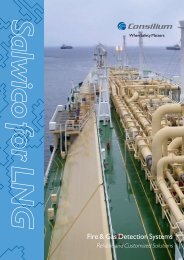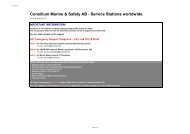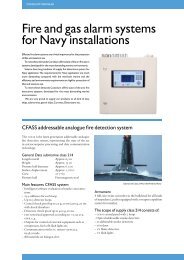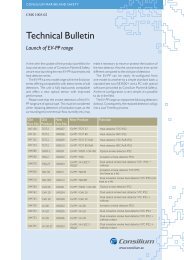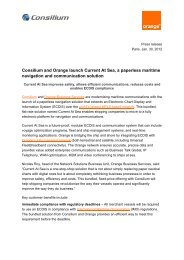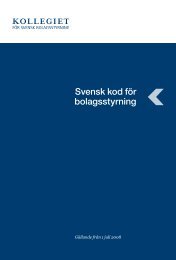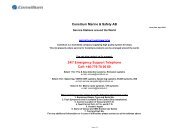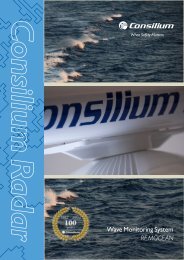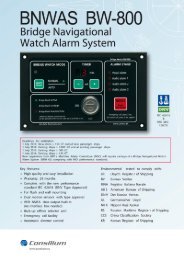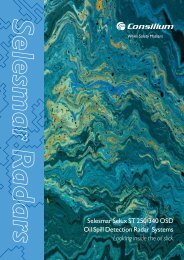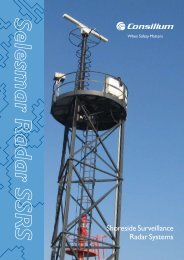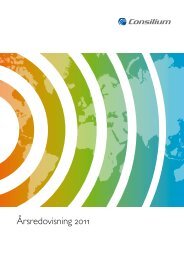Annual Report in English - Consilium
Annual Report in English - Consilium
Annual Report in English - Consilium
You also want an ePaper? Increase the reach of your titles
YUMPU automatically turns print PDFs into web optimized ePapers that Google loves.
Product development and research<br />
expenditure relat<strong>in</strong>g to development projects for the construction and test<strong>in</strong>g of new or<br />
improved products is capitalised under <strong>in</strong>tangible assets to the extent that such expenditure<br />
is expected to generate future economic benefits. other development expenditure<br />
is recognised as an expense <strong>in</strong> the period <strong>in</strong> which it is <strong>in</strong>curred. development costs<br />
previously recognised as an expense are not capitalised <strong>in</strong> subsequent periods. Capitalised<br />
development costs are amortised us<strong>in</strong>g the straight-l<strong>in</strong>e method over a period of<br />
3-5 years (the period <strong>in</strong> which future economic benefits are expected to flow to the<br />
company) from the date on which commercial production beg<strong>in</strong>s. <strong>in</strong> accordance with the<br />
ifRs transitional provisions <strong>in</strong> 2005, <strong>Consilium</strong> has reclassified the previously recognised<br />
goodwill aris<strong>in</strong>g from the acquisition of the net assets of nittan and servoteknikk <strong>in</strong> 2003<br />
and 2004. As a result of the reclassification, <strong>Consilium</strong>’s consolidated f<strong>in</strong>ancial statements<br />
now show product development acquisitions. At the acquisition date, the estimated<br />
useful lives and amortisation schedules were def<strong>in</strong>ed as 20 and 10 years, respectively. As<br />
these amortisation schedules are the same as those for previously recognised goodwill,<br />
there is no difference <strong>in</strong> amortisation charges. Amortisation is reported <strong>in</strong> the <strong>in</strong>come<br />
statement under Research and development costs.<br />
expenditure on research activities is recognised as <strong>in</strong>curred. Research is not conducted<br />
as a separate or large scale activity <strong>in</strong> the Group, but is an ongo<strong>in</strong>g process which forms<br />
an <strong>in</strong>tegral part of day-to-day operations. This type of expenditure can be difficult to<br />
dist<strong>in</strong>guish as research, and does not <strong>in</strong> any case represent significant amounts.<br />
Patents, trademarks and licences<br />
patents, trademarks and licences are recognised at cost. patents, trademarks and<br />
licences have f<strong>in</strong>ite useful lives, and are recognised at cost less accumulated amortisation.<br />
Amortisation is applied to patents, trademarks and licences us<strong>in</strong>g the straight-l<strong>in</strong>e method<br />
over their estimated useful lives (5-10 years).<br />
Property, plant & equipment<br />
property, plant & equipment, <strong>in</strong>clud<strong>in</strong>g land and <strong>in</strong>dustrial build<strong>in</strong>gs, is stated at cost less<br />
subsequent depreciation. Cost <strong>in</strong>cludes costs directly related to the acquisition of the<br />
asset. expenditure on improvement of an asset’s performance from its orig<strong>in</strong>al level <strong>in</strong>creases<br />
its carry<strong>in</strong>g amount. Repair and ma<strong>in</strong>tenance costs are recognised as an expense.<br />
depreciation is charged to operat<strong>in</strong>g profit <strong>in</strong> the <strong>in</strong>come statement and is applied us<strong>in</strong>g<br />
the straight-l<strong>in</strong>e method over the assets’ useful lives, based on the difference between<br />
their cost and residual value. <strong>Consilium</strong> applies the follow<strong>in</strong>g useful lives:<br />
<strong>in</strong>dustrial build<strong>in</strong>gs used <strong>in</strong> the course of bus<strong>in</strong>ess 25 years<br />
plant and mach<strong>in</strong>ery 5-7 years<br />
equipment, tools and fixtures & fitt<strong>in</strong>gs 5 years<br />
The residual values and useful lives of assets are reviewed annually and adjusted if<br />
necessary. if an asset’s carry<strong>in</strong>g amount exceeds its estimated recoverable amount, it is<br />
written down to the recoverable amount immediately. depreciation is not applied to land.<br />
Capital ga<strong>in</strong>s and losses are determ<strong>in</strong>ed by compar<strong>in</strong>g the sell<strong>in</strong>g price and the carry<strong>in</strong>g<br />
amount. Capital ga<strong>in</strong>s and losses are recognised <strong>in</strong> profit or loss.<br />
leases<br />
leases are classified as f<strong>in</strong>ance leases when the terms of the lease transfer substantially all<br />
the risks and rewards of ownership to the Group.<br />
Assets held under f<strong>in</strong>ance leases are recognised at their fair value at the <strong>in</strong>ception<br />
of the lease, or, if lower, at the present value of the m<strong>in</strong>imum lease payments. f<strong>in</strong>ance<br />
leases are reported under non-current assets and f<strong>in</strong>ancial liabilities <strong>in</strong> the balance sheet.<br />
future lease payments are apportioned between reduction of the lease obligation and<br />
f<strong>in</strong>ance charges so as to achieve a constant rate of <strong>in</strong>terest on the rema<strong>in</strong><strong>in</strong>g balance of<br />
the liability for each period. depreciation of leased assets is on a basis consistent with<br />
the normal depreciation policy for similar assets. Costs of leases are reported under<br />
depreciation and <strong>in</strong>terest <strong>in</strong> the <strong>in</strong>come statement. The Group did hold any assets under<br />
f<strong>in</strong>ance leases <strong>in</strong> 2011 or <strong>in</strong> 2010.<br />
A lease is classified as an operat<strong>in</strong>g lease if it does not transfer substantially all the risks<br />
and rewards of ownership. lease payments are recognised as an expense on a straightl<strong>in</strong>e<br />
basis over the term of the lease. operat<strong>in</strong>g leases are reported under operat<strong>in</strong>g<br />
expenses <strong>in</strong> the <strong>in</strong>come statement. leased cars, computers and premises are normally<br />
classified as operat<strong>in</strong>g leases.<br />
Impairment<br />
depreciation/amortisation is not applied to assets with an <strong>in</strong>def<strong>in</strong>ite useful life, such<br />
as goodwill; <strong>in</strong>stead, they are tested annually for impairment. The Group reviews the<br />
carry<strong>in</strong>g amounts of assets whenever there is an <strong>in</strong>dication that they may be impaired. if<br />
the recoverable amount of an asset is estimated to be less than its carry<strong>in</strong>g amount, the<br />
carry<strong>in</strong>g amount is reduced to the asset’s recoverable amount. The recoverable amount<br />
is the higher of the asset’s fair value less costs to sell and its value <strong>in</strong> use. impairment<br />
losses are recognised for each cash generat<strong>in</strong>g unit. Assets, other than f<strong>in</strong>ancial assets<br />
and goodwill, for which impairment losses have previously been recognised are tested at<br />
ACCountInG PolICIes<br />
each report<strong>in</strong>g date to determ<strong>in</strong>e whether there is any need for reversal of the previous<br />
impairment.<br />
Inventories<br />
<strong>in</strong>ventories consist of f<strong>in</strong>ished and semi-f<strong>in</strong>ished products and raw materials. <strong>in</strong>ventories<br />
are measured at the lower of cost and net realisable value at the report<strong>in</strong>g date. Cost<br />
is calculated us<strong>in</strong>g the first-<strong>in</strong>, first-out method. f<strong>in</strong>ished and semi-f<strong>in</strong>ished products are<br />
measured at the manufactur<strong>in</strong>g cost, <strong>in</strong>clud<strong>in</strong>g raw materials, direct labour, other direct<br />
overheads and production-related costs based on normal production. net realisable<br />
value is the estimated sell<strong>in</strong>g price <strong>in</strong> the ord<strong>in</strong>ary course of bus<strong>in</strong>ess, less the estimated<br />
variable costs necessary to make the sale. Collective measurement is used for groups of<br />
<strong>in</strong>ventories with similar characteristics. <strong>in</strong>ventory measurement does not <strong>in</strong>clude <strong>in</strong>terest<br />
costs. A deduction is made for <strong>in</strong>ternal ga<strong>in</strong>s aris<strong>in</strong>g from <strong>in</strong>tra-group deliveries. An<br />
obsolescence provision has been recognised.<br />
F<strong>in</strong>ancial <strong>in</strong>struments<br />
f<strong>in</strong>ancial <strong>in</strong>struments recognised <strong>in</strong> the balance sheet <strong>in</strong>clude cash & cash equivalents,<br />
trade receivables, current and non-current receivables, trade payables, loans and other<br />
liabilities.<br />
The Group classifies f<strong>in</strong>ancial assets <strong>in</strong>to the follow<strong>in</strong>g categories: cash & cash equivalents,<br />
loans and receivables and available-for-sale f<strong>in</strong>ancial assets. f<strong>in</strong>ancial assets are classified<br />
on the basis of the purpose for which they were acquired. management makes the<br />
classification decision on <strong>in</strong>itial recognition and reviews the decision at each report<strong>in</strong>g date.<br />
Loans and receivables<br />
loans and receivables are non-derivative f<strong>in</strong>ancial assets with fixed or determ<strong>in</strong>able payments<br />
that are not quoted <strong>in</strong> an active market. They are reported under current assets<br />
unless the settlement date is more than 12 months after the report<strong>in</strong>g date, <strong>in</strong> which<br />
case they are classified as non-current assets. loans and receivables are reported under<br />
trade receivables and other current and non-current receivables <strong>in</strong> the balance sheet.<br />
loan receivables are recognised at amortised cost us<strong>in</strong>g the effective <strong>in</strong>terest method.<br />
Trade receivables are <strong>in</strong>itially measured at fair value and thereafter at amortised cost<br />
us<strong>in</strong>g the effective <strong>in</strong>terest method less any provision for impairment losses. A provision<br />
for impairment losses is recognised when there is objective evidence that the carry<strong>in</strong>g<br />
amount of receivables will not be recovered, and an impairment loss is recognised when<br />
the loss is actually identified.<br />
Available-for-sale f<strong>in</strong>ancial assets<br />
Available-for-sale f<strong>in</strong>ancial assets are non-derivative f<strong>in</strong>ancial assets that have been<br />
designated as available for sale or have not been classified <strong>in</strong> any of the other categories.<br />
They are reported under non-current assets if management does not <strong>in</strong>tend to dispose<br />
of them with<strong>in</strong> 12 months of the report<strong>in</strong>g date. The assets are measured at fair<br />
value. Any changes <strong>in</strong> fair value are recognised directly <strong>in</strong> equity. An impairment loss<br />
is recognised if there is objective evidence of impairment. on disposal of the f<strong>in</strong>ancial<br />
asset, the cumulative ga<strong>in</strong> or loss previously recognised <strong>in</strong> equity is removed from equity<br />
and recognised <strong>in</strong> profit or loss. <strong>in</strong>vestments <strong>in</strong> available-for-sale equity <strong>in</strong>struments that<br />
do not have a quoted market price <strong>in</strong> an active market and whose fair value cannot be<br />
reliably measured are measured at cost. purchases and sales of f<strong>in</strong>ancial assets are recognised<br />
at the trade date (the commitment date). f<strong>in</strong>ancial assets are derecognised when<br />
the right to receive cash flows from the <strong>in</strong>strument has expired or been transferred, and<br />
the Group has transferred substantially all the risks and rewards of ownership.<br />
Cash & cash equivalents<br />
Cash & cash equivalents comprise cash on hand, bank deposits and short-term<br />
<strong>in</strong>vestments with an orig<strong>in</strong>al maturity of three months or less. Cash & cash equivalents<br />
are <strong>in</strong>itially recognised at fair value and thereafter at amortised cost.<br />
Hedge account<strong>in</strong>g<br />
<strong>Consilium</strong> uses derivative f<strong>in</strong>ancial <strong>in</strong>struments to cover risks associated with foreign<br />
currency exposure. <strong>Consilium</strong> designates certa<strong>in</strong> derivatives as hedges of highly probable<br />
forecast transactions for foreign currency exposure (cash flow exposure) with<strong>in</strong> the<br />
framework of the f<strong>in</strong>ancial policy def<strong>in</strong>ed by the Board. The Group applies hedge<br />
account<strong>in</strong>g for contracts which qualify for hedge account<strong>in</strong>g under iAs 39 f<strong>in</strong>ancial<br />
<strong>in</strong>struments: Recognition and measurement. At the <strong>in</strong>ception of the hedge and on an<br />
ongo<strong>in</strong>g basis, the Group documents whether the hedg<strong>in</strong>g <strong>in</strong>strument used <strong>in</strong> a hedg<strong>in</strong>g<br />
relationship is highly effective. unrealised ga<strong>in</strong>s and losses aris<strong>in</strong>g on the market valuation<br />
of hedg<strong>in</strong>g <strong>in</strong>struments and which meet the criteria for hedge account<strong>in</strong>g are recognised<br />
<strong>in</strong> equity. see also note 13.<br />
The fair value of a derivative which is a hedg<strong>in</strong>g <strong>in</strong>strument is reported under noncurrent<br />
assets or liabilities when the hedged item has a term to maturity of more than 12<br />
months, and is reported under current assets or liabilities when the hedged item has a<br />
term to maturity of less than 12 months.<br />
The effective portion of changes <strong>in</strong> the fair value of derivatives that are designated<br />
and qualify as cash flow hedges is deferred <strong>in</strong> equity. The ga<strong>in</strong> or loss relat<strong>in</strong>g to the<br />
39



